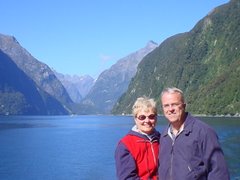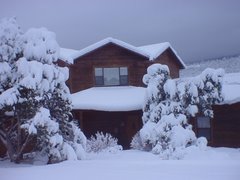Saturday we drove to Provincetown, at the end of the Cape - around 65 miles from our location. Along the way we took a few random detours through "Thickly Settled" and magnificent residential areas. There is a lot of weekend traffic on the Cape, so some of the trip was stop and go. Mostly stop. I was ready to turn back, but Susie urged me onward. Glad we persevered. A pleasant lunch stop restored our spirits.
Not long before Provincetown I saw a sign for a lighthouse. Turned off and found our way there. (This is known as trip planning.) Ach! It was the Cape Cod (Highland) Lighthouse. (Officially, it's the Cape Cod Lighthouse; it's known locally as the Highland Lighthouse because the terrain resembles the Scottish Highlands, including the golf course that adjoins it.)
The lighthouse, originally built in 1797, is on a bluff 174 ft. above sea level. A quote from a Rev. Levi Whitman, 1794, was posted in the little museum that said, "That mountain of clay in Truro seems to have been erected in the midst of sand hills by the God of Nature for the foundation of a lighthouse, which, if it should be obtained, in time no doubt would save the lives of thousands." A historian speaking on a video said that there were probably 3000-5000 wrecks off of this coast, so it was a dangerous place. WARNING: Ships Use Caution. Land may be nearer than it appears.
The current structure was built in
1857. The ocean continually eroded that mountain of clay so that by1990,
the lighthouse that was built 500 ft. back from ocean's edge was only 128 ft.
from it. By this time technology had rendered lighthouses obsolete, but
the area's residents felt it was important to preserve this bit of
history. They raised money and got governmental support and in 1996 the
430 ton structure was moved, on rails, 453 ft. further back. (Statistics problem for the reader: When will the lighthouse need to be moved again? Provide error bars.) The Coast
Guard operates the light, so the lighthouse is still doing its duty.
We drove on out toward land’s end in
search of a beach and picked one among several.
Got my feet wet in the Atlantic Ocean.
From there we drove in to
Provincetown. Our goal was the Pilgrim Monument, which the guide at the lighthouse had pointed out to us across the bay separating the lighthouse from Provincetown. (Nice pictures at the link.) I didn’t know this before this trip, but the
Pilgrims landed first on this part of Cape Cod.
They explored, found fresh water, and stayed a short while before moving
on to Plymouth, near the base of the cape. Here's a map for reference.
The streets were narrow and
crowded. I couldn’t find a way to the
monument. Turned, at one point, to
return to the road leading out of town and happened upon a sign pointing the
way to the Monument and parking.
Eureka!
At the base of the tower is an interesting
museum about Provincetown and the Pilgrims.
After storms kept them from their planned Virginia destination, the Pilgrims (Wikipedia is my source) landed here on Nov 11, 1620, and right away established rules
for governance, the Mayflower Compact. Most everyone stayed on board the Mayflower through the winter, while others scouted for a better site, finally selecting what became Plymouth. The settlers disembarked there in March, 1621. Just about half of the settlers and crew had survived the journey.
I'm waving at Susie who is in the pickup down there in the parking lot - a dark red blob, backed up against the trees, in line with the left end of the tennis court, next to a white blob.
The committee met Monday and Tuesday at the National Academy
of Science's Jonsson Center in Woods
Hole. Rather than summarize I'll just copy and paste its history from the
the website.
In 1884, James Marshall, a
stockbroker who lived and worked in New York City, and who had summered at the
Quissett Harbor Hotel in Woods Hole Massachusetts, purchased property on the
harbor on which to build a summer cottage for his family. After completing the
estate which included the Carriage House and a sizable dwelling (now the Wheeler
House) and enjoying 8 summers in that house, the family desired a larger, more
formal residence. The original house was moved at the end of the summer season
in 1906 by workers using wench horses and an earthen ramp to a location on a
hill opposite Quissett Avenue slightly to the right of the drive as you exit
the Center. This was a challenging feat for the day and made more exacting by
the fact that it was moved with the furniture, family belongings and stone
chimneys intact.
The new house was a replica of the
earlier one, with enlarged rooms, the addition of the rear porch and rooms
above, formalized fireplaces, added servant's quarters and pantries, and many
decorative and ornamental features. Completed in just 11 months, the residence
was ready when the family arrived the following July. A remarkable
accomplishment, but made possible by the availability of the ships carpenters
in surplus as a result of the fading whaling industry and the resulting reduced
ship building.
The Marshall's had three children,
two girls and a boy. In time the ownership of the house passed to one of the
Marshall's daughters, who sold it in 1934 to Mr. Hobart Ames of Boston. Again
it passed to the heirs, who in turn sold it to Mr. Howard Houston. In 1975, the
National Academy of Sciences purchased the house from Mr. Houston to use as a
site for holding meetings of the Academy and the National Research Council
during the late spring, summer, and early fall months.
Preservation and restoration efforts
have been accomplished gradually and are ongoing. As projects of any magnitude
have been identified, great authentic reproduction, and identical or superior
quality materials are specified in order to ensure the architectural integrity
of the structures.
Here's a picture copied from
the website:
My picture of the view looking out:
My meeting was Monday and Tuesday. We left Wednesday, headed for Montreal. Next report: Woodstock, NH.
Susie and Rob




















No comments:
Post a Comment